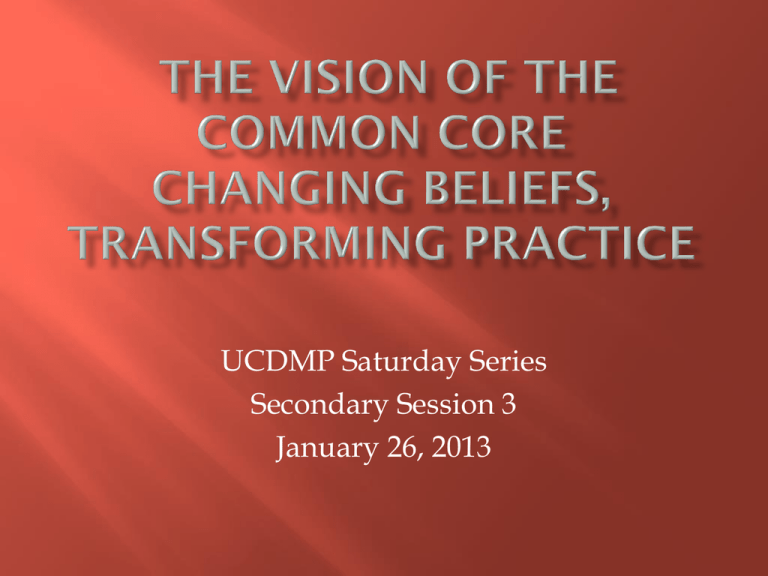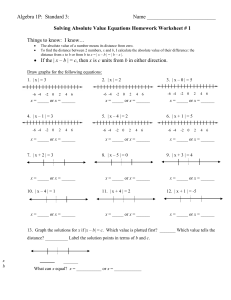1/26/13 Secondary Morning Session Powerpoint
advertisement

UCDMP Saturday Series Secondary Session 3 January 26, 2013 An Algebra Warm-Up Introduction to the CCSS Standards for Mathematical Practice, SMP 4 and SMP 5 Algebra and Algebraic Thinking in Secondary School Wiring a Calendar Lunch Small Group Breakout sessions Feedback and Reflection 1. 2. 3. 4. 5. 6. 7. 8. Make sense of problems and persevere in solving them. Reason abstractly and quantitatively. Construct viable arguments and critique the reasoning of others. Model with mathematics. Use appropriate tools strategically. Attend to precision. Look for and make use of structure. Look for and express regularity in repeated reasoning. 1. Make sense of problems and perseveres in solving them 6. Attend to precision OVERARCHING HABITS OF MIND REASONING AND EXPLAINING 2. Reason abstractly and quantitatively 3. Construct viable arguments are critique the reasoning of others MODELING AND USING TOOLS MODELING AND USING TOOLS 4. Model4. with mathematics Model with mathematics 5. Use appropriate tools strategically 5. Use appropriate tools strategically SEEING STRUCTURE AND GENERALIZING 7. Look for and make use of structure 8. Look for and express regularity in repeated reasoning Mathematically proficient students can apply the mathematics they know to solve problems arising in everyday life, society, and the workplace. In order to model with mathematics, students need to make simplifying assumptions about a context. It is important for students to have opportunities to do this in very familiar contexts before they are asked to do the more complex task of making such assumptions (based on appropriate research) for unfamiliar or scientifically complex contexts, as they will be asked to do in high school. Full-blown modeling tasks require many different skills, including sifting through information and deciding what is relevant, interpreting graphs, locating information needed to solve a problem, and making simplifying assumptions. Students need opportunities to work on this skills a few at a time as well as in concert. How many snow cones would I have to sell at the Davis “Picnic in the Park” if I wish to make a profit of $200? What is the best way to package soda cans? What dimensions would you recommend to a company for packing their straws? Given the weight and height of King Kong, could he really have existed? How often should you feed the birds so they keep coming back? One of the Break-Out sessions this afternoon will look further into Modeling Mathematically proficient students consider the available tools when solving a mathematical problem. These tools might include pencil and paper, concrete models, a ruler, a protractor, a calculator, a spreadsheet, a computer algebra system, a statistical package, or dynamic geometry software. Proficient students are sufficiently familiar with tools appropriate for their grade or course to make sound decisions about when each of these tools might be helpful, recognizing both the insight to be gained and their limitations. For example, mathematically proficient high school students analyze graphs of functions and solutions generated using a graphing calculator. They detect possible errors by strategically using estimation and other mathematical knowledge. When making mathematical models, they know that technology can enable them to visualize the results of varying assumptions, explore consequences, and compare predictions with data. Mathematically proficient students at various grade levels are able to identify relevant external mathematical resources, such as digital content located on a website, and use them to pose or solve problems. They are able to use technological tools to explore and deepen their understanding of concepts. From Appendix A: Strategic use of technology is expected in all work. This may include employing technological tools to assist students in forming and testing conjectures, creating graphs and data displays and determining and assessing lines of fit for data. Geometric constructions may also be performed using geometric software as well as classical tools and technology may aid threedimensional visualization. Testing with and without technological tools is recommended. Two of the Break-Out sessions this afternoon will look further into Using Tools. Let’s take a 10 minute break. See you back here at ________ K-8 Domains High School Categories Take a look at the document: Algebra and Algebraic Thinking in the CCSS-M Grades 6-12 Create a map depicting a students “Algebraic Journey” from 6th grade through High School. Where do they begin? What is their destination? What are some of the important “must-sees” along the way? 6th: Expressions and Equations Apply and extend previous understandings of arithmetic to algebraic expressions. Reason about and solve one-variable equations and inequalities. Represent and analyze quantitative relationships between dependent and independent variables. 7th: Expressions and Equations Use properties of operations to generate equivalent expressions. Solve real-life and mathematical problems using numerical and algebraic expressions and equations. 8th: Expressions and Equations Work with radicals and integer exponents. Understand the connections between proportional relationships, lines, and linear equations. Analyze and solve linear equations and pairs of simultaneous linear equations. 8th: Functions Define, evaluate, and compare functions. Use functions to model relationships between quantities. 11th: Algebra Interpret the structure of expressions. Write expressions in equivalent forms to solve problems. Perform arithmetic operations on polynomials. Create equations that describe numbers or relationships. Understand solving equations as a process of reasoning and explain the reasoning. Solve equations and inequalities in one variable. Represent and solve equations and inequalities graphically. 11th: Functions Understand the concept of a function and use function notation. Interpret functions that arise in applications in terms of a context. Analyze functions using different representations. Build a function that models a relationship between two quantities. When you come back from lunch we will break you into three smaller group. Each group will attend three breakout sessions designed to give you a more in depth experience with Modeling and Using Tools. All three sessions will take place in this room and you will rotate through them. The final 10 minutes of the afternoon will be devoted to feedback, signing out and getting your certificates.



